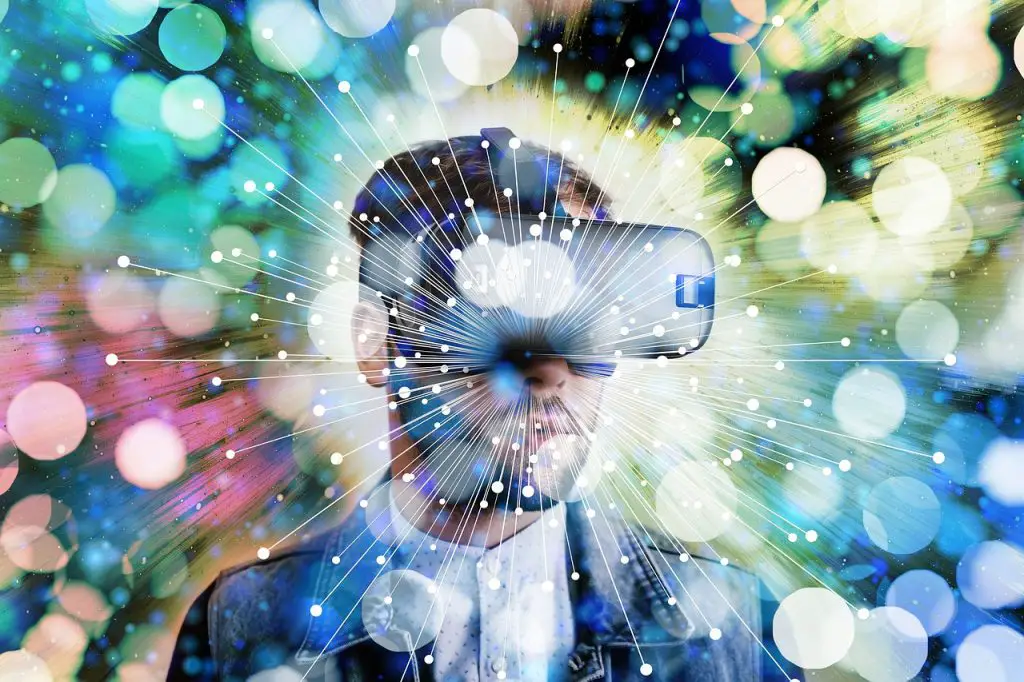Virtual reality (VR) is a technology that enables users to experience immersive digital environments that can simulate the physical world or create entirely new ones. Through VR, users can interact with these digital environments in a way that feels natural and intuitive, using specialized hardware and software to create a sense of presence and engagement. In this essay, we will explore what virtual reality is, how it works, and some of its potential applications.
At its core, virtual reality is a technology that creates a sense of presence and immersion in digital environments. This is achieved through a combination of specialized hardware and software, including headsets, controllers, and software engines that create the virtual world. The most common hardware component of VR is the headset, which typically includes a display screen and sensors that track the user’s movements and orientation. The display screen is positioned close to the user’s eyes, creating a stereoscopic effect that makes the digital world appear three-dimensional.
In addition to the headset, VR often includes hand-held controllers or other input devices that enable users to interact with the virtual world. These controllers may include buttons, triggers, or other input mechanisms that allow users to manipulate objects, navigate through the environment, and perform other actions. Some VR systems also incorporate other sensory feedback, such as sound, haptic feedback, or even scent, to further enhance the sense of presence and immersion.
To create the virtual world itself, VR relies on specialized software engines that can render 3D graphics and simulate physics and other aspects of the environment. These engines can create environments that simulate real-world locations, such as a city street or a forest, or entirely fictional environments, such as a fantastical realm or a space station. The software engines may also incorporate artificial intelligence (AI) or other algorithms to simulate the behavior of virtual characters, animals, or other entities within the environment.
The process of creating a virtual reality experience typically involves several stages. First, the digital environment is designed using specialized software tools, which may include 3D modeling software, animation software, or game engines. Once the environment has been designed, it is then optimized and tested to ensure that it can be rendered in real-time on the target hardware. Finally, the VR experience is packaged into a software application that can be downloaded and installed on the user’s device.
One of the most exciting aspects of virtual reality is its potential applications in a wide range of fields, including gaming, education, healthcare, and architecture, among others. In the gaming industry, VR enables players to experience immersive worlds and interact with virtual characters in ways that were previously impossible. VR gaming has already seen significant growth in recent years, with major companies like Sony, Facebook, and Valve investing in VR hardware and software development.
In the education sector, VR has the potential to transform the way that students learn and interact with course materials. VR can enable students to explore historical sites, perform scientific experiments, or experience simulations of complex systems in a way that is engaging and interactive. VR can also provide access to learning materials and experiences that would be difficult or impossible to access in the physical world, such as remote locations or dangerous environments.
In the healthcare industry, VR is being used to improve patient outcomes and enhance medical training. VR simulations can enable medical professionals to practice procedures and treatments in a safe and controlled environment, reducing the risk of errors and improving patient safety. VR can also be used to treat mental health conditions, such as anxiety and phobias, by exposing patients to controlled virtual environments that help them to overcome their fears.
In architecture and design, VR can enable designers and architects to visualize and test their designs in a virtual environment before they are built in the physical world. This can help to identify potential design flaws or issues before they become costly or time-consuming to fix. VR can also enable clients to experience and provide feedback on a design before it is built, allowing for greater collaboration and communication between the design team and the client.
While virtual reality has many potential applications, it is not without its challenges and limitations. One of the primary challenges of VR is the need for specialized hardware, which can be expensive and may require significant processing power to run. This can limit the accessibility of VR to certain users and may require significant investment in hardware and software development.
Another challenge of VR is the potential for motion sickness and other discomforts that can arise from prolonged use of VR headsets. This is due to the disconnect between the user’s visual and physical senses, which can lead to nausea, headaches, and other symptoms. To mitigate these effects, VR developers have implemented a range of techniques, including reducing latency, increasing refresh rates, and designing environments that are less likely to induce motion sickness.
In conclusion, virtual reality is a technology that enables users to experience immersive digital environments that can simulate the physical world or create entirely new ones. Through a combination of specialized hardware and software, users can interact with these environments in a way that feels natural and intuitive, creating a sense of presence and immersion. While virtual reality has many potential applications in fields like gaming, education, healthcare, and architecture, it is not without its challenges and limitations. As VR technology continues to develop, we can expect to see even more exciting and innovative applications in the future.







